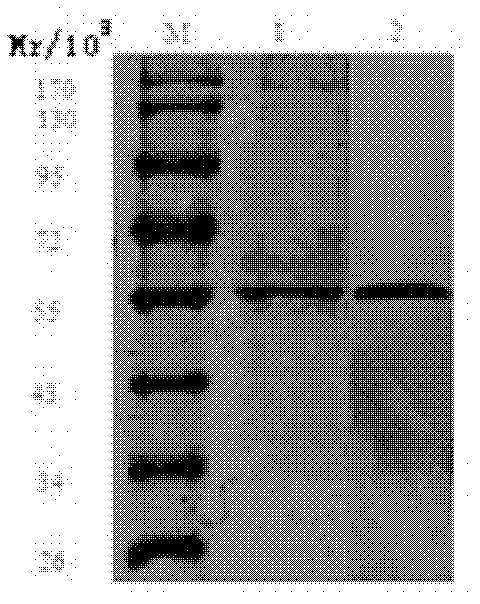Vascular Endothelial Growth Factor (VEGF) acceptor 2/CD3 bispecific single-chain antibody
A growth factor receptor, single-chain antibody technology, applied in the direction of anti-receptor/cell surface antigen/cell surface determinant immunoglobulin, antibody, anti-animal/human immunoglobulin, etc., to achieve small molecular weight, immunogen The effect of low performance and high yield
- Summary
- Abstract
- Description
- Claims
- Application Information
AI Technical Summary
Problems solved by technology
Method used
Image
Examples
Embodiment Construction
[0028] 1. Design of bscVEGFR2×CD3 gene fragment and construction of expression vector
[0029] According to VL VEGFR2 , VH VEGFR2 , VH CD3 , VL CD3 The sequence of the amino acid sequence and functional domains VL VEGFR2 -(Gly 4 Ser) 3 -VH VEGFR2 -Gly 4 Ser-VH CD3 -(Gly 4 Ser) 3 -VL CD3. Add the HindIII restriction site, KOZAK sequence and secretion signal peptide sequence in sequence at the 5' end of the sequence, design the KOZAK sequence GCCACCATG before the start codon ATG, which can improve the translation initiation efficiency, and add the secretion signal peptide sequence after ATG (SEQ ID NO: 5) for secretory expression in mammalian cells. Six histidine tags and an EcoR I restriction site were sequentially added to the 3' end of the sequence, and the histidine tags facilitated the purification and identification of recombinant bispecific antibodies. The schematic diagram of the whole gene sequence of bscVEGFR2×CD3 is: KOZAK-Secretary signal sequence-VL V...
PUM
 Login to View More
Login to View More Abstract
Description
Claims
Application Information
 Login to View More
Login to View More - R&D
- Intellectual Property
- Life Sciences
- Materials
- Tech Scout
- Unparalleled Data Quality
- Higher Quality Content
- 60% Fewer Hallucinations
Browse by: Latest US Patents, China's latest patents, Technical Efficacy Thesaurus, Application Domain, Technology Topic, Popular Technical Reports.
© 2025 PatSnap. All rights reserved.Legal|Privacy policy|Modern Slavery Act Transparency Statement|Sitemap|About US| Contact US: help@patsnap.com



